Potato pest and disease solution
- Biological Control
-
- Commodity name: Potato pest and disease solution

Potatoes, one of the world’s most widely consumed crops, play a vital role in global food security. However, their cultivation is not without challenges. Potato pests and diseases can significantly impact both the quality and quantity of the harvest. These issues have prompted farmers and researchers to seek effective solutions to ensure a steady supply of healthy potatoes for consumption. In this article, we will delve into the various potato pests and diseases that pose threats to potato cultivation and explore sustainable strategies to combat them. From understanding the intricacies of potato bugs to implementing organic farming techniques, we will uncover the best ways to grow and harvest potatoes while keeping these destructive elements at bay.
Potato Pests
Potato Diseases
Bacterial Ring Rot (Clavibacter michiganensis subsp. sepedonicus)
Potato Pests
Colorado potato beetle (Leptinotarsa decemlineata)

Features
The adult Colorado potato beetle is about 10mm in length, with a distinct yellow-orange body and five bold black stripes along its wing covers. The larvae are reddish-orange with a row of dark spots on each side.
Symptoms
- Holes or pits on potato leaves
- Skeletonized leaves (only veins remain)
- Defoliation (loss of leaves)
- Presence of yellow or orange eggs on the undersides of leaves
- Larvae with reddish-brown humped bodies and black head capsules
Integrated pest management (IPM)
- Crop rotationcan disrupt the beetle’s life cycle and reduce the likelihood of infestations.
- Regularly inspect potato plants for signs of Colorado potato beetles (CPB) infestation, such as adult beetles, larvae, eggs, and defoliation.
- In the early stages, consider handpickingand crush or dispose of them
- If you prefer organic methods,Use insecticides such as MET Zone or Metarhizium anisopliae or Bacillus thuringiensis (Bt) or Neem Oil.
Potato Aphids (Macrosiphum euphorbiae)

Features
Potato aphids are typically green in color, but they can also be yellow, pink, or almost black, depending on their stage of development and environmental conditions. They have a pear-shaped body, long antennae, and two tube-like structures called cornicles on their posterior end.
Symptoms
- Curling of leaves
- Yellowing of leaves (chlorosis)
- Stunted plant growth
- Distorted or misshapen leaves
- Presence of small green, yellow, pink, or black insects on the plant
- Sticky honeydew residue on leaves
- Black sooty mold growth on plant surfaces
Management
- Crop rotation and planting resistant potato varieties can help reduce aphid populations.
- Monitor plants regularly for aphid presence.
- Remove weeds and debris near potato plants to reduce aphid habitat.
- Encourage natural predators like ladybugs and lacewings.
- Prune heavily infested plant parts and dispose of them properly.
- Apply insecticides like BEVERIA WP or Beauveria bassiana or Pyrethrin-Based Products
Potato leafhoppers (Empoasca fabae)

Features
Potato leafhoppers are small insects that belong to the family Cicadellidae. These leafhoppers are about 3 mm in length and are green or yellowish-green in color. Their feeding causes damage to plants, resulting in the characteristic symptom known as “hopperburn.”
Symptoms
- Yellowing and browning of leaf edges (marginal burn)
- White stippling or speckling on leaves
- Formation of hopperburn or V-shaped yellow patches
Management
- Avoid excessive use of nitrogen fertilizers.
- Implement cultural practices, such as removing weed hosts and practicing crop rotation.
- Regularly scout fields and monitor leafhopper populations using sticky traps, sweep nets, or visual inspections.
- Encourage and conserve natural predators of Potato leafhoppers, such as ladybugs, lacewings, predatory bugs, and parasitic wasps.
- Apply insecticides like Myco Pestop or Metarhizium anisopliae when leafhoppers are in their nymphal stage
Potato psyllid (Bactericera cockerelli)

Features
The potato psyllid (Bactericera cockerelli) is a small insect that belongs to the psyllid family, also known as jumping plant lice. They are about 3 to 4 mm (approximately 0.12 to 0.16 inches) in length. Adult potato psyllids have mottled greenish-brown to black bodies with white markings on the thorax and wings.
Symptoms
- Development of purple or reddish pigmentation on leaves (called “purple top” symptom)
- Presence of small, winged psyllids on the underside of leaves
- Zebra Chip disease: Dark, striped patterns in the flesh of infected potatoes when fried.
Management
- Remove and destroy infected plants promptly to prevent further spread.
- Implement crop rotation to disrupt the psyllid life cycle and reduce infestations.
- Biological soil amendments and beneficial microorganisms can improve soil health and indirectly affect pest populations.
- Apply insecticides like BEVERIA WP or Beauveria bassiana when psyllid populations exceed recommended thresholds.
Wireworms (Agriotes spp.)

Features
Wireworms are the larval stage of click beetles belonging to the genus Agriotes. Wireworms get their name from their slender, worm-like appearance, and they are usually yellow, brown, or black in color.
Symptoms
- Irregular or small holes on potato tubers.
- Presence of small, dark-colored, slender larvae in the soil.
- Damaged or tunneled roots and underground stems.
Management
- Use beneficial nematodes as biological control agents against wireworms.
- Plow the field in late summer to expose wireworms to predators and harsh environmental conditions.
- Apply insecticides like MET Zone or Imidacloprid or Thiamethoxam or Fipronil specifically targeted at wireworm larvae when necessary.
Cutworms (Agrotis spp. and other genera)
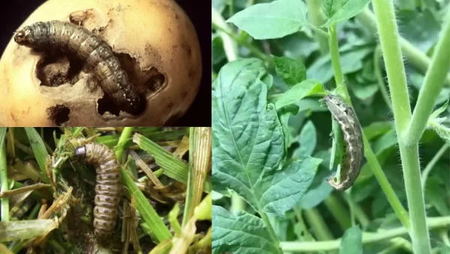
Features
Cutworms are the larvae of various species of nocturnal moths in the family Noctuidae. Cutworms are caterpillar-like larvae with smooth bodies and no legs. They are usually gray, brown, or black in color and have a cylindrical shape. Cutworms are especially active in cool and damp weather conditions.
Symptoms
- Young plants cut off at or just above ground level.
- Presence of chewed or damaged stems and leaves.
- Holes or tunnels in the soil around the base of potato plants.
Management
- Use physical barriers like collars or cardboard around young plants to protect them.
- Handpick and remove cutworms found in the soil near affected plants.
- Natural enemies of cutworms, such as parasitic wasps and predatory beetles, can be encouraged to help control their populations.
- Some beneficial nematodes, like Steinernema feltiae and Steinernema carpocapsae, are natural predators of cutworm larvae to help control cutworm populations.
- Apply insecticides like Met Zone or Permethrin or Spinosad specifically targeting cutworm larvae when necessary.
Blister beetles (Epicauta spp.)
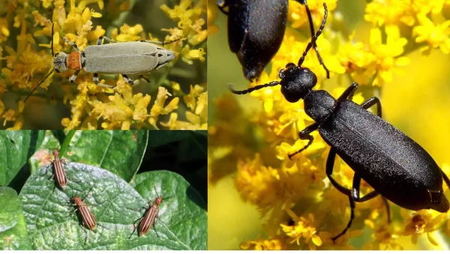
Features
Blister beetles are a family of beetles known as Meloidae. There are many species of blister beetles, and they can vary in size and coloration. One unique characteristic of blister beetles is their ability to release a defensive chemical substance called cantharidin. Cantharidin is highly toxic and can cause skin blisters and irritation in humans and other animals upon contact.
Symptoms
- Defoliation: Stripped or skeletonized leaves due to beetle feeding.
- Damage to flowers and buds.
- Presence of brightly colored beetles on potato plants.
Management
- Diversifying crops in the area can disrupt the Blister beetle’s life cycle and reduce the attractiveness of a monoculture that they might prefer.
- Shake beetles off plants and collect them manually.
- Use physical barriers like row covers to protect young plants.
- Apply insecticides such as Pyrethroids or imidacloprid or clothianidin or carbaryl or methomyl if beetle populations exceed thresholds.
Potato tuber moth (Phthorimaea operculella)

Features
The Potato tuber moth (Phthorimaea operculella) is a small, destructive moth species that belongs to the family Gelechiidae. The adult moths have a wingspan of about 10-12 mm. The forewings of adult moths are grayish-brown with darker markings and a distinct pattern of two pale spots.
Symptoms
- Accumulation of sawdust-like frass around the entrance holes.
- Soft, rotting areas on the potato tuber caused by larval feeding.
- Pupal cases or silken threads on the surface of infested potatoes.
Management
- Implement proper crop rotation to reduce pest buildup.
- Inspect and remove infested potatoes regularly to prevent spreading.
- Apply insecticides such as BT Thuricide, Spinosad and Pyrethroids if necessary, following recommended guidelines and thresholds.
Nematodes (e.g., Potato Cyst Nematode)

Features
Nematodes are typically elongated and cylindrical in shape, with a slender, unsegmented body. They can range in size from a few millimeters to several centimeters in length.Some species are plant-parasitic and can damage potato plants.
Symptoms
- Formation of galls or knots on roots (root-knot nematodes).
- Brown spots or lesions on roots (lesion nematodes).
- Small cysts on roots (cyst nematodes).
Management
- Avoid waterlogging or over-irrigation, as nematodes thrive in wet conditions.
- Apply organic matter and compost to improve soil health.
- Use nematicides such as Nema Pro and Nema ProMax if needed, following guidelines.
Whiteflies (Bemisia tabaci)

Features
Whiteflies are small, winged insects belonging to the Aleyrodidae family. Whiteflies are tiny insects, about 1-3 mm in length. They have a distinctive appearance with white, powdery wings that are held in a roof-like position over their body when at rest.
Symptoms
- Yellowing of leaves (chlorosis) due to feeding and sap removal.
- Sticky honeydew secretions on leaves, leading to sooty mold growth.
- Presence of tiny whiteflies on the underside of leaves.
Management
- Use reflective mulches or sticky traps to deter and capture whiteflies.
- Introduce natural enemies like ladybugs and lacewings.
- Use insecticides such as Myco Pestop, insecticidal soap, neem oil and Pyrethrin if infestations are severe and thresholds are exceeded.
Flea Beetles (Epitrix spp.)

Features
Flea beetles are small, jumping beetles belonging to the Chrysomelidae family. They are common agricultural pests and can affect various crops, including potatoes. Adult flea beetles and their larvae feed on plant leaves, causing damage and reducing plant vigor.
Symptoms
- Tiny holes or pits on potato leaves due to feeding.
- Shiny, metallic-colored beetles jumping and crawling on the plants.
- Wilting and stunted growth in severe infestations.
Management
- Use floating row covers to protect young potato plants.
- Use physical barriers like cardboard collars around young plants.
- Apply insecticides such as Myco Pestop, Carbamates, Pyrethroids and Spinosads if beetle populations exceed thresholds.
Leaf Miners (Liriomyza spp.)

Features
Leaf miners are the larvae of various insects, including flies, moths, and beetles. They feed on the tissue inside leaves, creating tunnels or mines as they eat their way through. Leaf miners can affect a wide range of plants, including potatoes.
Symptoms
- Serpentine or winding mines on potato leaves.
- White or yellowish trails visible on the leaf surface.
- Presence of small maggots or larvae inside the mines.
Management
- Remove and destroy heavily infested leaves.
- Practice good field sanitation and remove weed hosts.
- Apply insecticides such as Spinosad and Azadirachtin targeted at leaf miner larvae when necessary.
Spider Mites (Tetranychus spp.)

Features
Spider mites are tiny arachnids that belong to the Tetranychidae family. They are common agricultural pests and can infest various plants, including potatoes. Spider mites feed on plant sap, causing damage to leaves and reducing plant vigor.
Symptoms
- Yellowing and stippling of leaves due to feeding.
- Fine webbing present on the underside of leaves.
- Premature leaf drop in severe infestations.
Management
- Use predatory mites or beneficial insects to target pest populations.
- Use strong water sprays to dislodge mites from leaves.
- Apply insecticides such as BEVERIA WP, Horticultural oil and Azadirachtin to control spider mites.
Stalk Borers (Papaipema spp.)

Features
Stalk borers are the larvae of certain moths and beetles that belong to various insect families. They are known for tunneling and feeding inside the stems and stalks of plants, including potatoes. Stalk borers can cause significant damage to potato crops.
Symptoms
- Presence of entry holes or burrows in the stems.
- Frass or excrement near the entry holes.
- Boreholes in the tubers in severe infestations.
Management
- Remove and destroy infested plants to prevent further spread.
- Introduce natural enemies, like parasitic wasps, to control stalk borer populations.
- Apply insecticides such as Myco Pestop, Pyrethroids, Carbamates and Spinosyns when necessary.
Armyworms (Spodoptera spp.)

Features
Armyworms are the larvae of various moth species in the genus Spodoptera. They are named for their behavior of moving in large groups like an army, consuming vegetation as they march. Armyworms are known to be voracious feeders and can cause damage to a wide range of crops, including potatoes.
Symptoms
- Rapid defoliation of potato plants due to heavy feeding.
- Irregular holes and chewed edges on leaves.
- Presence of caterpillars on the plants, often in large numbers.
Management
- Handpick and remove caterpillars from plants if feasible.
- Introduce parasitic wasps to control armyworm populations.
- Apply insecticides such as Myco Pestop, Carbamates, Pyrethroids and Spinosads when necessary.
Potato Diseases
Late Blight (Phytophthora infestans)

Features
Late blight is a highly destructive and contagious fungal disease that affects potatoes and tomatoes. It is caused by the pathogen Phytophthora infestans and is responsible for devastating historical famines, including the Irish Potato Famine.
Symptoms
- Dark, water-soaked lesions on leaves, often starting at the edges.
- Development of white, fluffy mold on the underside of leaves during damp weather.
- Browning and rotting of stems and petioles.
Management
- Practice good field sanitation and remove infected plant debris.
- Avoid excessive irrigation and maintain proper plant spacing.
- Apply fungicides such as Cropium, Chlorothalonil and Mancozeb to protect plants.
Early Blight (Alternaria solani)

Features
Early blight is a common fungal disease that affects potatoes and other solanaceous crops, caused by the pathogen Alternaria solani. It can lead to significant yield losses if not properly managed.
Symptoms
- Small, dark brown lesions with concentric rings on potato leaves.
- Lesions often start on lower leaves and spread upwards.
- Yellowing and wilting of affected leaves.
Management
- Plant in well-drained soil and maintain proper plant spacing.
- Remove and destroy infected leaves and debris.
- Apply fungicides Cropium, Chlorothalonil and Mancozeb to protect plants.
Rhizoctonia (Rhizoctonia solani)
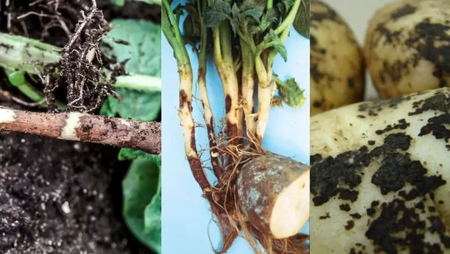
Features
Rhizoctonia solani is a fungal pathogen that causes various diseases, including black scurf and stem canker, in potatoes. It can also affect other crops and is widely distributed in agricultural soils.
Symptoms
- Black, dark brown, or reddish-brown lesions on potato tubers.
- Presence of dark, sunken cankers on potato stems.
- Black, thread-like structures (sclerotia) on the surface of tubers and stems.
Management
- Improve soil drainage to reduce disease incidence.
- Plant in well-prepared, weed-free soil.
- Apply fungicides such as Bactonus, Chlorothalonil, Mancozeb and Thiram to protect plants.
White Mold (Sclerotinia sclerotiorum)
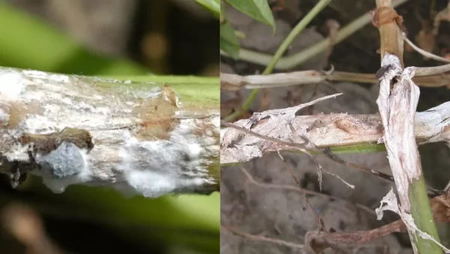
Features
White mold, also known as Sclerotinia rot or stem rot, is a fungal disease that can affect various crops, including potatoes. It is caused by the pathogen Sclerotinia sclerotiorum.
Symptoms
- Development of hard, black, resting structures called sclerotia.
- Wilting and collapse of affected plants.
- Rotting and decay of stems and petioles.
Management
- Improve air circulation and reduce plant density.
- Avoid excessive irrigation and overhead watering.
- Apply fungicides such as Trianum Shield, methyl bromide and chloropicrin to protect plants.
Blackleg (Erwinia spp.)
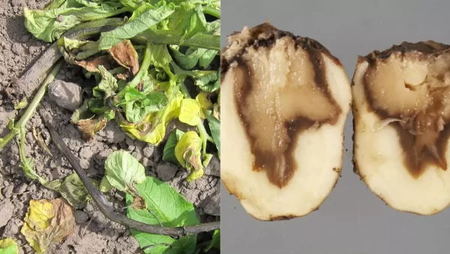
Features
Blackleg is a bacterial disease in potatoes caused by various species of the genus Erwinia, particularly Erwinia carotovora subsp. atroseptica and Erwinia carotovora subsp. carotovora. It can lead to significant economic losses in potato crops.
Symptoms
- Black, water-soaked lesions on stems and petioles.
- Foul odor emanating from infected tissues.
- Wilting and death of affected stems and leaves.
- Soft rot and decay of stems and tubers.
Management
- Remove and destroy infected plants and tubers promptly.
- Improve air circulation and reduce plant density.
- Apply bactericides such as Bactonus, Bacteriophages and copper-based fungicides to protect plants.
Common scab (Streptomyces scabies)

Features
Common scab is a bacterial disease in potatoes caused by the bacterium Streptomyces scabies. It affects the surface of the tubers, leading to scabby and rough-textured patches.
Symptoms
- Rough, corky, or scaly patches on potato tubers.
- Irregular lesions with tan, brown, or black discoloration.
- Superficial, raised scabs on the tuber surface.
Management
- Use scab-resistant potato varieties if available.
- Improve soil health and reduce soil pH to below 5.2.
- Apply bactericide such as Bactonus and Bacteriophages.
Powdery Scab (Spongospora subterranea)

Features
Powdery scab is a soil-borne disease in potatoes caused by the pathogen Spongospora subterranea. It affects the tubers, causing wart-like growths and reducing market value.
Symptoms
- Small, raised, powdery pustules or scabs on potato tubers.
- Wart-like growths on the surface of tubers.
- Rough and corky patches on the skin of tubers.
Management
- Improve soil drainage and reduce compaction.
- Rotate crops with non-host plants to reduce pathogen levels.
- Apply fungicides such as Trianum Shield and methyl bromide and chloropicrin.
Potato virus Y (PVY)
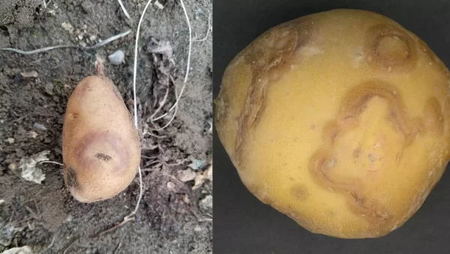
Features
Potato virus Y (PVY) is a plant virus that affects potatoes and is one of the most economically important viruses in potato production. It can cause significant yield losses and reduce tuber quality.
Symptoms
- Necrosis or browning of leaf veins.
- Rings or line patterns on tubers.
- “Potato tuber necrotic ringspot disease” in some strains, leading to brown rings or necrosis on tubers.
Management
- Remove and destroy infected potato plants.
- Apply mineral oil sprays to potato plants.
- Treat seed potatoes with heat therapy to eliminate PVY infection.
Potato Wart Disease (Synchytrium endobioticum)
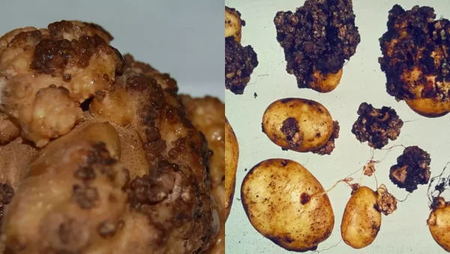
Features
Potato Wart Disease is a serious fungal disease caused by the pathogen Synchytrium endobioticum. It affects potato tubers, causing wart-like growths that can reduce market value and limit trade.
Symptoms
- Wart-like growths or galls on the surface of potato tubers.
- Irregularly shaped and rough-textured growths.
- Reduced market quality and marketability due to warting.
Management
- Choose potato varieties that exhibit resistance to potato wart disease.
- Liming infested soil to a pH of 5.8 or higher.
- Fumigating infested soil with chemicals like methyl bromide or chloropicrin.
Bacterial Ring Rot (Clavibacter michiganensis subsp. sepedonicus)

Features
Bacterial Ring Rot is a serious bacterial disease in potatoes caused by the pathogen Clavibacter michiganensis subsp. sepedonicus. It can lead to significant yield losses and affect potato storage.
Symptoms
- Yellow to brown ring-shaped lesions in tuber vascular tissue.
- Internal browning and breakdown of tubers.
- Presence of slimy bacterial ooze when tubers are cut.
Management
- Remove and destroy infected plants and tubers promptly.
- Disinfect tools and equipment between uses.
- Use bactericide such as Cropium on seed potatoes if allowed.
Fusarium Wilt (Fusarium oxysporum)

Features
Fusarium wilt is a fungal disease caused by Fusarium oxysporum. While it is commonly known to affect other crops, it can also impact potatoes, leading to yield losses.
Symptoms
- Wilting and yellowing of potato plants, starting from the lower leaves.
- Browning and discoloration of vascular tissues in the stem.
- Reduced plant vigor and stunted growth.
Management
- Improve soil drainage to reduce disease incidence.
- Avoid over-irrigation and waterlogged conditions.
- Apply fungicide such as Cropium and chemicals like methyl bromide.
Brown Rot (Ralstonia solanacearum)

Features
Brown rot is a bacterial disease caused by the pathogen Ralstonia solanacearum. It can affect various solanaceous crops, including potatoes, and can lead to significant economic losses.
Symptoms
- Browning and necrosis of vascular tissues in stems.
- Dark, brown streaks in the tuber vascular tissue.
- Rapid wilting and death of infected plants.
Management
- Rotate crops with non-host plants.
- Avoid planting potatoes in infested fields.
- Use bactericides such as Bactonus, Streptomycin and Oxytetracycline on seed potatoes if allowed.
Verticillium Wilt (Verticillium spp.)

Features
Verticillium wilt is a fungal disease caused by various species of the genus Verticillium. It affects a wide range of plants, including potatoes, and can lead to reduced yields.
Symptoms
- Brown discoloration and drying of leaf margins and tips.
- Vascular browning in stems.
- Stunted growth and reduced plant vigor.
Management
- Practice crop rotation with non-host plants.
- Improve soil drainage to reduce disease incidence.
- Use bactericides such as Cropium and antagonistic microorganisms, such as Trichoderma harzianum.
Corky Ringspot (CRS)

Features
Corky Ringspot is a viral disease affecting potatoes, caused by Tobacco rattle virus (TRV) and transmitted by soil-borne nematodes (Trichodorus spp.).
Symptoms
- Formation of circular, corky rings or arcs on tubers.
- Rings are often tan to brown in color and raised on the surface.
- Affected areas can be sunken or depressed, reducing market value.
Management
- Choose potato varieties that exhibit resistance to corky ringspot when available.
- Hill around the base of plants to protect tubers from sprinkler irrigation or rain splash, which can spread TRV.
- Treat seed potatoes with fungicide such as Cropium.
In conclusion, successfully cultivating potatoes while minimizing the impact of pests and diseases requires a multi-faceted approach. As potato bugs and various diseases continue to challenge farmers, the adoption of integrated pest management practices proves to be an effective strategy. By combining cultural, biological, and chemical control methods, growers can mitigate the damage caused by pests while preserving the integrity of the environment. Embracing organic farming practices not only promotes healthier potato crops but also supports long-term sustainability. Remember, the best way to grow and harvest potatoes involves a holistic understanding of the ecosystem, a proactive stance against pests and diseases, and a commitment to producing not only abundant but also high-quality organic potatoes. Through ongoing research and collaboration, the agricultural community can continue to develop innovative solutions to ensure the world’s potato supply remains resilient in the face of challenges.
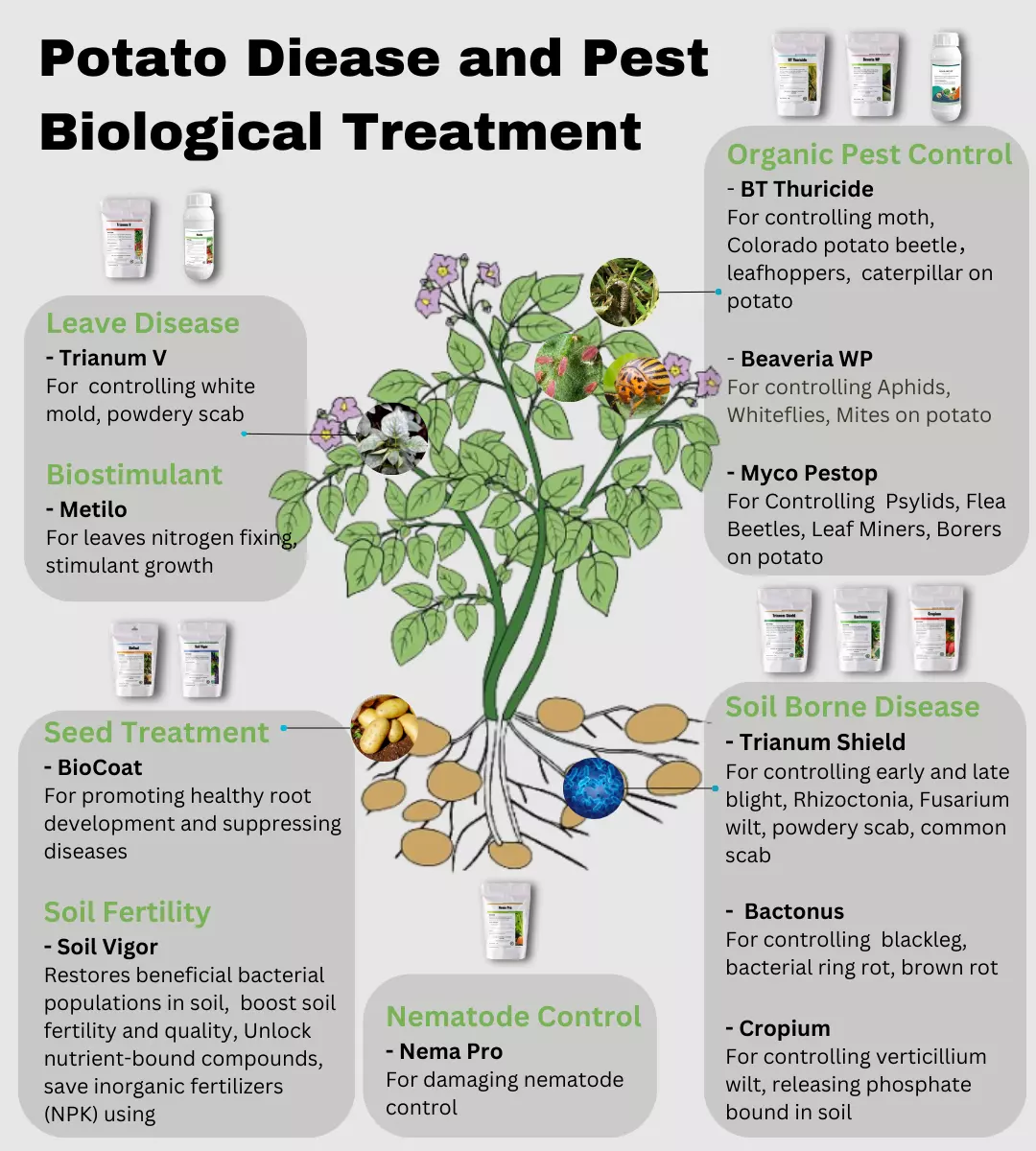
Related Products
CONTACT US

Office 38/1502, No 660,Hanguang Rt., Changsha City, Hunan, China



































